

Italy travel requirements 2024: What travelers need to know
We aim to keep this post updated about Italy travel in 2024 with official Italy travel restrictions, requirements, and health and safety guidance. Our goal is to help you make informed decisions so you can travel confidently, safely, and responsibly in this new post-pandemic world of ours.
Italy has a special place in our hearts, and we finally returned in Fall 2022.
As restrictions vary based on the traveler’s citizenship, we will focus primarily on rules affecting U.S. citizens.
Last update: January 28, 2024. Originally published: July 2020.
* Get our free Post-Pandemic Travel Checklist *
Photo credit: Annalisa, Rome January 2024: “Tourism in Italy right now is flourishing, and although it is low season, there is a considerable amount of travelers both in art cities such as Rome, Florence, and Venice, and in small villages. In tourist spots such as museums and archaeological areas there are no restrictions of any kind, except in cases of overbooking such as for the Colosseum in Rome, so I recommend booking tickets at least two months in advance. The business of restaurants, hotels, and vacation homes is normal and busy. Access to health care takes place as usual, with regular and free access to checkups and treatment through hospital emergency rooms for Italian residents and nonresidents. As for Covid tests, although they are not required by any tourist facility, they can be done in all Italian pharmacies for a cost of €10-15.” -Annalisa of Rome Travelogues , Resident of Italy
At the end of the post, we share on-the-ground perspectives from local residents and travelers to Italy so you’ll get a true sense of what to expect.
Table of Contents
Can US citizens travel to Italy? Can I travel to Italy right now?
Italy is open to all travelers, including US citizens who are traveling for tourism.
As of June 2022 , all travelers, including US citizens are no longer required to show a vaccination, recovery, or test certificate upon arrival to Italy. All travelers can enter Italy without quarantine.
Most Italy travel restrictions have been lifted as of May 1 for activities inside the country. See regional restrictions here and regional zone classifications here .
Visitors from over 60 visa-exempt countries , including the U.S., will soon be required to have a European Travel Information and Authorisation System (ETIAS) travel authorization to enter Italy and other European countries . The start date has been delayed from 2024 to 2025.
See details about ETIAS here
Quarantine rules in Italy: What happens if I get Covid?
Travelers are not required to quarantine upon arrival in Italy.
For those who test positive for Covid while in Italy, self-isolation for five days or until testing negative, followed by masking up to 10 days, was the latest requirement. More recently, locals report that quarantine is no longer being enforced.
Italy Green Pass Requirements to Enter Restaurants, Attractions and Large Events
You might be wondering: Do I need a vaccine certificate or Covid test to enter restaurants and attractions in Italy?
Italy’s green pass (basic or super green pass) is no longer required to access restaurants, businesses, public transport, or participate in certain activities.
However, the Super Green Pass is still temporarily required for anyone age 12 and older to access hospitals or care homes.
Can Americans travel to Italy in April 2024? Can US citizens travel to Italy this Spring?
Travel to Italy in April is open . Read on for details and check back for updates.
What is it like to fly to Italy FCO or CIA Rome International Airport right now? In Rome, body temperature checks through thermo scanners may be taken at the entrance of the airports. The airports sanitize their spaces daily.
For travelers entering Italy from other countries, check with your airline about current mask requirements on board.
Do Americans have to quarantine when traveling to Italy? Quarantine is not required upon arrival.
See details above.
Does Italy check COVID-19 symptoms of incoming travelers? Body temperature may be scanned in the airports for inbound and outbound travelers.
Does Italy require a negative Covid 19 test for American travelers? A negative Covid test is no longer required to enter Italy.
Does Italy require a proof of Coronavirus vaccine for American travelers? Proof of Coronavirus vaccine is no longer required to enter Italy.
Do I still need to provide a negative Covid test or quarantine if I have been vaccinated? Neither proof of vaccination, negative test, nor quarantine are required to travel to Italy.
Is a booster shot required for travel to Italy? A booster shot is no longer required to enter Italy.
However, a booster shot is needed for the US vaccination card to be considered a valid Green Pass to enter healthcare settings while in Italy. See Green Pass Requirements above.
What Covid testing options are available for travelers in Italy? PCR and antigen tests are available for U.S. citizens and visitors in Italy. Antigen tests cost approximately 20-30 euros while PCR tests can cost around 70.
Individuals in Italy can get a Covid test from the following:
- Government-approved testing labs
- Testing facilities with English-speaking doctors in Italy
- On-site testing facilities at international airports in Italy, such as Milan, Rome Fiumicino, Cagliari, Florence, Malpensa, Bari, Venice, Pisa, and others.
- Private testing labs and pharmacies in Italy
What healthcare options are available to travelers in Italy who get the virus? Tourists and visitors may access Italian health care and emergency services by paying out of pocket or with privately purchased travelers’ insurance. Tourists can also contact the Italian Covid hotline at 1500 (free toll number).
For travel insurance that covers Covid, check out Nomad Insurance by Safety Wing >
What service businesses and restaurants are open in Italy? Bars, restaurants and all other establishments are open. Both indoor and outdoor dining are allowed.
Are face masks required in Italy? As of October 2022, wearing of masks in Italy is no longer mandatory except in healthcare settings.
Are buses and trains running in Italy? Public transportation is available throughout Italy at normal capacity. Masks are no longer required on buses, trains, etc.
Will Italy impose new Covid restrictions? What’s next is difficult to predict. Historically, most countries impose COVID-19 restrictions when strains on the health care system might become unsustainable.
How has the Coronavirus impacted Italy?
Italy was the first country in Europe affected by COVID-19 and was hit hard by the outbreak, requiring strict lock downs. Another large spike in cases occurred at the end of October 2020. A nationwide state of emergency continued through 2022.
Italy’s economy, which includes a large tourism sector, has faced its deepest recession in history. More than 200,000 tourism-related jobs were discontinued in Italy by the end of 2021– accounting for a massive shortage of workers in the country.
In May 2021, Italy formally opened its borders to international travelers from select countries to revive tourism. In June, Italy eased its restrictions for international travelers, then tightened somewhat due to the Delta variant and Omicron variant.
Italy’s state of emergency ended on March 31, 2022.
Italy obtains its vaccines via an EU procurement program. On December 27, 2020, Italy vaccinated the first residents against COVID-19. Currently, three quarters of Italians are fully vaccinated.
For the current situation in Italy – including how bad is covid in Italy today, total COVID-19 positive cases; daily number of cases in Italy; and COVID-19 recovery rates in Italy, please see the statistics here .
What should you pack for safely traveling in Italy?
😷 Face Masks – Face coverings are recommended in public spaces and required in healthcare settings. Find N95 masks at Bona Fide > or designer options at Vida >
💊 Medicine – Bring enough prescription and over-the-counter medication for your entire trip to avoid trips to the clinic.
💳 Vaccine Card Holder – Protect that paper CDC card when traveling abroad (if your country doesn’t offer a digital version). Get a simple plastic protector > or Vegan leather clippable > or Leather passport + card combo holder >
👃 Covid self-test – The most studied rapid antigen self-test with FDA emergency authorization. NOT valid to enter countries. Use for your own peace of mind. Order from CVS > or Walmart >
💧 Sealed water bottle – Make sure your reusable water bottle has a lid that’s not exposed to the air. We use one of each of the following: Shop insulated water bottles with protective lid > Shop water bottles with purification filter and protective lid >
✈️ Travel insurance that covers Covid – We’ve started using Nomad Insurance by Safety Wing for affordable evacuation, international medical, and trip coverage.
What do Italian locals and recent travelers say about visiting Italy now?
What is it like to visit Italy right now? It’s our goal to provide regular updates here from real people on the ground, to help potential visitors know what to expect.
The following are subjective opinions only. Official travel guidance can be found above.
October 2023 – Louisa Loring of EatingAroundItaly , resident of Italy: “Expect to come to Italy and travel as freely as before the COVID pandemic. Currently, there are no laws or recommendations for masking, social distancing or public gatherings. Today, all historic monuments are open as usual without restrictions.
There is no requirement for those who show symptoms. The Italian public healthcare system has removed its state of emergency and it’s easy to access the emergency room.. Private healthcare facilities are free to test patients if they choose too.
Since COVID, there has been an enormous increase in pre-bookings for museums in Italy. Although not all museums require that you pre-book, most people do and it can save you a lot of time waiting in line. Most museums have an easy and hassle free online booking system with paperless tickets.”
September 2023 – Linda of insieme-piemonte.com , resident of Italy: “Italy has, especially in summer, many crowded places. However, beautiful Piedmont, in the northwest of the country, remains a hidden gem: cheap, hospitable and visited by Italians at most in high season.
At the moment, Covid is no longer an issue. There are no restrictions or protective measures. During the pandemic, however, very strict rules prevailed throughout the country, including house arrest for several weeks.”
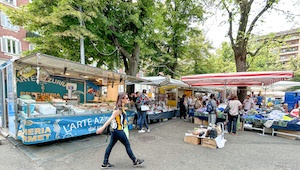
June 2023 – Natalie Deduck of Best of Turin , visitor: “My husband and I come to Turin to stay a month and later travel to other destinations in Italy.
The main tourist destinations such as Rome, Amalfi Coast, Florence, and Milan are receiving a tremendous influx of tourists this Spring and Summer. We are glad that we choose Turin for our longer stay. It is an incredible destination but not as famous as the other places, so here we can enjoy all the best of Italy without hassling with crowds.
Since I landed in Italy, I didn’t see any advice or signals about Covid measures or how to behave in public spaces. No one wears masks, and businesses are open as usual, including bars, restaurants, clubs, museums, and open-air markets.
Everything is pretty much back to normal. My husband and I lived in Turin in 2019 and 2020 during the pandemic. We experienced Italy in its worst moment, and it’s so good and heartwarming to see life back to what it was before the pandemic.”
January 2023 – Zoe of Together In Switzerland, EU visitor: “For our visit to Como, Italy for 2023, the location was pretty busy and lively. All shops and restaurants are open and seemed like a good mix of locals and tourists.
It’s not mandatory, but many do choose to wear a mask such as on the local bus or when in the main shopping area. There were absolutely no checks during our whole visit in Como, however you do see that local stores do still have a those plastic protection areas at the cashier tills and hand sanitizers is available at entrances. We personally didn’t see many people using these and no minimum space was needed. The only crowded area we encountered was for a busy local restaurant that everyone wanted to eat at.”
October 18 2022 -Michelle, Intentional Travelers: “Italy’s tourism feels back in full force and daily life has resumed as normal. Some people wear masks in grocery stores, trains, or other public areas but not many. On the train back to Rome airport, we saw staff sanitizing handrails in all the train cars. Lines at FCO airport seemed typical, and we passed through check-in, security and customs relatively quickly (25 minutes) on a weekday morning. We didn’t have to show any Covid documents, only passports.”
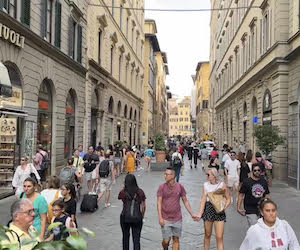
September 2022 – Michelle, Intentional Travelers: “We flew into Florence, Italy and took trains through Tuscany in September. To enter Italy, we only needed our passports. Air Dolomiti airlines required masks on the flight.
The Florence airport tram into town had signs that masks were required but maybe 50% of people were masked. Around Florence, it is as busy as ever and highly recommended to make reservations for big attractions in advance. Masks were still required on the regional trains in Italy, enforced by staff and audio announcements. Otherwise, tourism does seem back to normal.”
June 3, 2022 – S.M, American digital nomad – “I flew today to Rome from Croatia. They didn’t ask for anything covid related. No test or vax cards. But we had to wear N95 mask on the plane, that’s it.”
May 2022 – Lyndsay at thepurposelylost.com : “I’ve been living in Italy and exploring the country for six months now, and the past few days were the busiest I’ve seen the cities! As the weather gets warmer, we’re expecting an uptick in tourism, which is definitely what I’ve encountered so far. Tourists are eager to experience la dolce vita again!
Although you don’t need to wear a mask walking around outside, masks are still required on public transportation like busses, metros, and trains, and highly encouraged for all inside spaces like restaurants and shops. You’ll even find a mix of people wearing masks at public outdoor events.”
March 24, 2022 – Heather American/Italian dual citizen: “I flew into Rome and then proceeded to take several trains and a bus to get to a tiny village in Abruzzo where I will be living for the next five months. Masks are required inside all buildings, and most buildings have signs indicating you need to show a Super Green Pass for entrance. Trains and buses did check for my Super Green Pass and my CDC card showing my booster was accepted readily.
Italians are still taking things pretty serious, regarding masks, etc.”
March 2, 2022 – Sarah Wilson of Life Part 2 and Beyond , British visitor: “I’m in Florence for 10 days learning Italian. I was surprised how many tourists were here over the weekend. Queues were long to many of the major sites. They do check your Green Pass every time you enter a tourist attraction, and restaurant. Some shops also insist on seeing your Green Pass but not all. Masks are being worn inside but not needed outdoors.
There are plenty of pharmacies, many offer COVID testing or the rapid antigen tests. All the pharmacists in a city like Florence speak great English. To reduce waiting in line, I recommend booking attraction tickets online in advance.”
Candice of Mom in Italy , Permanent Resident: “It’s a nice time to visit because you can visit places like the center of Florence and its museums without any crowds.
We’ve also been visiting smaller villages like Pienza, Montepulciano, and San Gimignano, but they’re a little too empty. Almost all shops and restaurants are closed, due to the lack of local visitors. For anyone thinking of coming to Italy right now, I’d stick to the bigger cities, where you’re guaranteed to find things open and still full of Italian ‘vita.’
Throughout the entire pandemic, I’ve been impressed by the cooperation of Italians. People here wear masks when/where required and for the most part, respect the rules. Visitors need to follow the rules too – for example, if you don’t have the Green Pass here, you can’t sit down in an indoor restaurant. Owners don’t distinguish between locals and tourists – everyone has to have their Green Pass scanned or checked.
It’s easy to get tested in Italy – there are private clinics and you can also get tested in pharmacies. You can also get English translations easily. It’s not a great time to come to Italy if you aren’t vaccinated (or have proof of recovery from COVID within the last 6 months). Pretty much anything you’d want to do as a tourist right now requires the Green Pass.
We haven’t found any long lines or crowds, although I expect there will be an influx of visitors in the spring because Italy’s precautions help make it a less risky destination and people are ready to come back to Italia!”
January 2022 – Claudia of Strictly Rome , Italian resident: “All attractions and places of interest for tourists are currently open in Italy. Visits to restaurants typically start with the staff coming to the table to check your “green pass” (the Italian vaccination card). Much like locals, tourists are required to show proof of vaccination or of having recovered from Covid to access attractions, restaurants, hotels and transport – including trains and local / city buses. Everyone in Italy follows the rules, wearing masks wherever required and showing their vaccination card to access public places, restaurants, attractions, transportation and the like. Antigen tests are available at any pharmacy, best if upon booking and depending on the city and region in Italy there may be a line to get tested. Access to health care remains free for everyone on Italian territory, including visitors. You will be significantly better off making restaurant reservations as with Covid restrictions and social distancing availability for tables in popular tourist destinations may be limited.”
December 2021 – Or of My Path in the World , Israeli traveler: “I flew to Turin for a one week leisure trip in December 2021. I felt very safe in Turin as everything was well organized and it seemed like the locals were determined to live “normally” again. Everyone follows the current restrictions, and some people even wear masks outdoors though it’s not mandatory. You can’t enter a museum or a restaurant without your Green Pass being scanned (unless you’re sitting outside), and some attractions require a reservation in advance because you need to pick a specific timeslot for your visit. There are quite a few places for covid tests, and a PCR test for your flight back home will cost you about 70 Euros.”
November 30, 2021 – Morgan Fielder, Crave the Planet , E.U. expat: “It’s so great and easy to get reservations at awesome restaurants with fewer tourists. The airports in Italy have gotten more efficient and travel has been extremely easy since August if you are vaccinated and keeping your mask on appropriately. Yes, people follow the rules. Access is good to hospitals and if there’s any hint of problems, then businesses and events have gone to only letting in vaccinated or recovered people. Contract tracing is done via app when you go inside a venue or restaurant.”
September 20, 2021 – Sarah Wilson , British expat in Malta: “I was in northern Italy at the beginning of September for two weeks and now I’m in Sicily until the end of the month. The locals are very welcoming. It’s been a tough time for many businesses in Italy, so they are very happy to receive tourists. I literally had Rome to myself, so if you enjoy travelling without the crowds, now is the time to visit. To enter any restaurant, museum or tourist site, you do have to show your vaccine certificate. Some places like the restaurants in Lake Como also asked for your name and phone number. Masks are worn on all public transport and indoors and majority comply. Sicily has recently turned yellow which means masks are supposed to be worn indoors and outdoors – very few wear them outdoors – it’s too hot.”

August 2021 – Abigail, American traveler : “I went to Italy for a weekend. I felt safe and all of the stores were open. There was a green pass that people used to dine indoors, however since I’m a US Citizen I did not have one. Instead I showed my vaccination card, and it was asked for at every establishment. They did not ask for the Covid pass for public transport for Venice or Milan during my stay. For sit down restaurants, they wouldn’t let you in the door if you could not show vaccination. I did see a lot of seats for outdoor dining everywhere I went though.”
August 2021 – Caroline A., South African/Italian visitor: “My husband, 7 year old son, 4 year old daughter and I are in Rome for three months for an adventure as we have dual citizenship. Tourists are very much welcome in Rome at the moment although museums are requiring the green pass to enter. Since we are not vaccinated, we have been getting tested for entering museums, which lasts 48 hours. Testing is widely accessible. Most attractions are open for visits with covid protocols in place. There is a festive mood in the air as many people take their vacation over this time. It is wonderful not to have to wear a mask outside.”
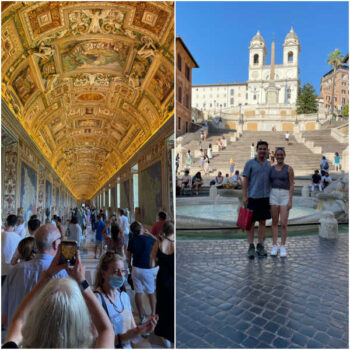
July 2021 – Kathryn, American Traveler: “I flew from Spain to Naples, Italy and stayed 2 days in Positano, 2 days in Sorrento, and 4 days in Rome. The locals were happy to have patrons in their cafes and restaurants. We had several people tell us how happy they are to see return of tourism. All public transportation was running as it would pre-pandemic (masks always required). We took planes, trains, taxis, boats and buses with no restrictions. Some restaurants required you to write down name, phone number, country of origin for contact tracing. Otherwise, no restrictions for outdoor dining and tables were quite close to each other as you would typically experience in Europe. Indoor dining often had more space between tables to allow for social distancing. In Rome, there were quite a few walk-up COVID testing tents throughout the city to use if needed. Rome sights were much less crowded than what I’ve experienced past summers. All major tourist sites were open. They offered both advance tickets and walk-up (usually wouldn’t be possible due to large numbers of tourists in the summer, but with less tourists this year it was possible to purchase day-of tickets). They had temperature checks at most major sites and required masks if indoors.”
June 2021 – Alexander and Cynthia, Travel your Memories , Dutch visitors: “We flew to Rome and visited for 4 days. After Rome we travelled to Florence for 2 days. Because you can do many activities outside, Italy is prefect to travel to at the moment. The population pays very close attention to the guidelines of COVID. All sights have been adjusted accordingly. Only a maximum number of people are allowed in the shops (depending on the size). If you get cold symptoms, you can go to a test street. For major sights it is important to book your ticket in advance because you have to fix a time slot.”
May 2021 – Sarah, Benvenuti Arts, American: “I have a visa as I’m here to teach at a University, and traveling into Italy felt joyful! The crew on the flight were so happy to see us all, and there were only about 30 passengers on the plane. The customs officials were very nice and the people doing COVID-testing in the airport were very friendly. While the rules, as read, seemed more strict than the US, I’m noticing people’s interpretation of those rules is just as scattered as in my country. I happened to arrive right when they reopened after the Easter lockdown, and people seem to be thrilled to be outside. We wear masks in all public areas, and there is no indoor dining, so in general it feels safe. But I am finding myself a bit overwhelmed by crowded areas, like places where students hang out. That’ll take some time to get used to again! I would say, if someone is traveling soon, be respectful and be overprepared. Rules were changing weekly in the lead up to my visit, so I have so much documentation printed that I haven’t needed. Everything takes a bit more preparation than you might be used to in Italy, too. Some restaurants require reservations. Museums are open, but with timed, pre-reserved tickets. There is no indoor dining. There’s a curfew. I am usually loose with my planning when I travel, but am doing more of it just because it’s required. But the food is amazing, the people are lovely, and the city is beautiful, so even with some adaptations, it’s amazing to be here!”
April 2021 – Chicca, Cooking in Tuscany , Italian resident: “We have been living a lockdown life since October – I have to say we’ve got so use to it. But just these days our prime minister has announced to relax some of the strict coronavirus measures starting April 26. The vaccination plans are rolling out quite consistently to have the majority of the population vaccinated by this summer. I read here and there that maybe borders will be opening first to Europeans and then to Americans. We don’t know when but, yes, I start dreaming of having visitors again.”
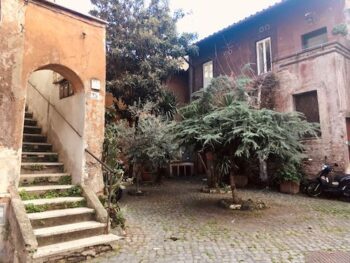
January 2021 – Clotilde, A Princess Travelling with Twins , Italian living abroad: “I flew to Rome, with my husband and our twins over the Christmas period for 10 days to visit family. People working in the tourist sector are really welcoming and try their best to respect, and make customer respect, the rules and regulations. They have been suffering a lot from the lack of tourists and all the imposed restrictions, so they are happy to see tourists coming back but other people are more cautious. News of the new variants of the virus have particularly made people more alert. The biggest issue when travelling to Italy right now is the rules change really quickly, the country can ban specific countries without warning as happened over Christmas with people coming from the UK. On top of that, each Italian region is defined by a colour depending on the level of the infection rate. This reflects also in services opening times that change unexpectedly and often forget to update their websites or search engines. For example you could be stranded at the airport wondering what to do as the rental car office where you booked your vehicle has closed and the curfew time is approaching, as happened to us! “
September 2020. Rebecca Ann Hughes, journalist – permanent resident of Venice: “Tourist numbers in Italy have been low all summer. For those who come to visit, they are seeing popular tourist destinations as never before, but many businesses are struggling. Locals whose work is fed by tourism are eager to welcome back visitors but many of them, along with those who do not work in the tourism sector, are pushing for a change in tourism. Particularly in Venice, they want visitors who travel “slow”, who are respectful, and who interact with the community. This includes following COVID regulations imposed by local councils and the government. Recently, a tourist on a vaporetto (waterbus) in Venice refused to wear a mask, angering locals and causing a fight to break out. Visitors should be well prepared to follow the regulations in Italy, even if they differ from their home country.
Most tourist attractions, public transport, restaurants, bars and other amenities are open and functioning as normal, albeit with social distancing rules and the obligation to wear a mask. It is possible that some tourist attractions will require advanced booking and may have longer queues if the venue is taking temperatures upon entry. Visitors may often have their temperature taken when entering a restaurant. When entering a building or getting on public transport, use hand sanitiser if it is provided. Testing booths have been set up in many airports and visitors can download a contact tracing app for Italy.”
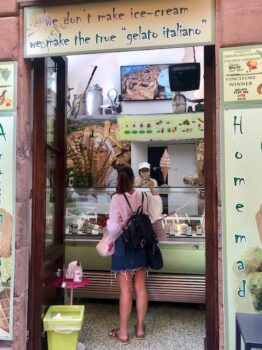
Planning a trip to Italy?
Check out our other Italy travel resources: – Self Guided Walking Tour of Florence – Lucca Day Trip Guide & Walking Tour – A Guide to Tuscany’s Etruscan Coast – Cooking in Tuscany Classes – Hiking Cinque Terre Itinerary – Packing List for Europe in Fall/Winter – 7 Hidden Gem Towns on Tuscany’s Coast – Best Beaches in Tuscany Italy – Tuscany Castles to Rent or Visit – Why Visit Italy in September
If you have questions or updates about travel to Italy during the Coronavirus crisis or post-pandemic, please let us know in the comments below.
~ Pin this post for later or share with friends ~
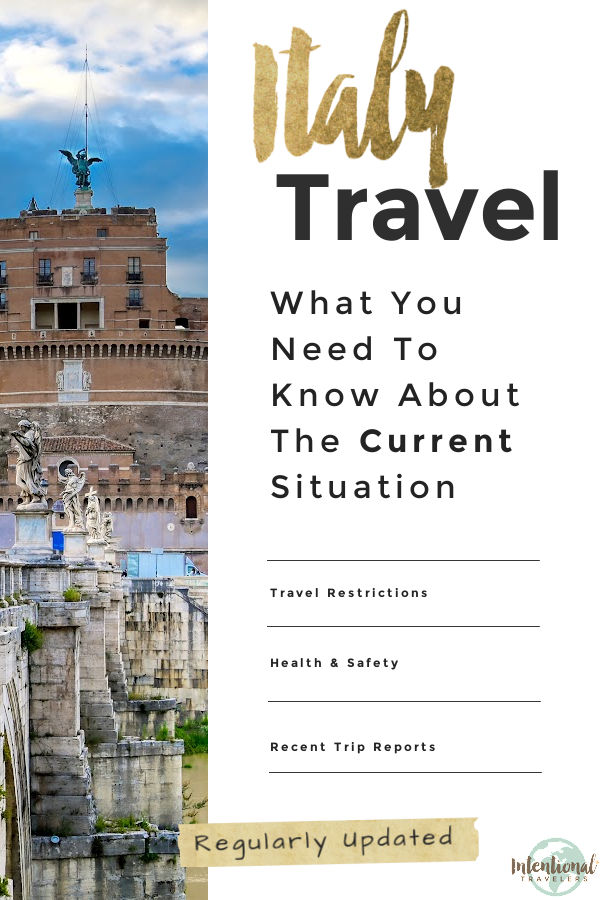
Disclaimer: Please note, travel restrictions change frequently. Readers must take responsibility for verifying information through official sources like the State Department and CDC, in respect to their specific situations. No responsibility can be accepted by Intentional Travelers for action or inaction as a result of information provided through IntentionalTravelers.com. Any information provided here is issued as general information only.
Similar Posts

Rome Food Tour – A Progressive Meal Through The Jewish Quarter With Bitemojo
We’re excited to tell you about a new and exciting way to enjoy a food tour in Rome. With the help of your smartphone, you can experience a progressive meal through secret corners of Rome, at your own pace. You get the benefits of a curated experience with local insights, without the cost or time…

Cooking in Tuscany With Chicca: One Day Home Cooking Classes in Italy
At the heart of Italian culture is – of course – Italian food. That’s why one of the best cultural experiences for visitors to Italy is a cooking class. If you’re looking for one day cooking classes in Tuscany, then we have a great recommendation for you! Cooking in Tuscany with Chicca is not only…

10 of the Most Beautiful Villages in Italy
We’re excited to share this guest post with you from Rebecca Hughes of La Brutta Figura: Unlocking Italy. She’s a Scottish travel writer, adopted by Italy, who took on a challenge we’d love to do ourselves: visiting all of the most beautiful villages in Italy! Today Rebecca is sharing some of her best finds with…
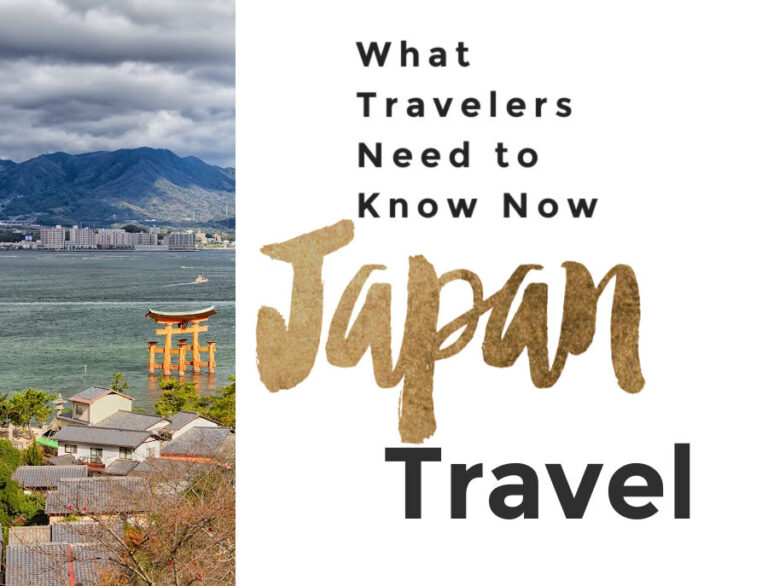
Japan travel requirements 2024: What travelers need to know
We aim to keep this post updated about Japan travel in 2024 with official Japan travel restrictions, requirements, and health and safety guidance. Our goal is to help you make informed decisions so you can travel confidently, safely, and responsibly in this new post-pandemic world of ours. Since travel restrictions can vary by citizenship, we…

Merida Mexico travel requirements 2024: What travelers need to know
We aim to keep this post updated about Merida Mexico travel in 2024 with official Yucatan travel restrictions, requirements, and health and safety guidance. Our goal is to help you make informed decisions so you can travel confidently, safely, and responsibly in this new post-pandemic world of ours. The Covid situation in Merida, Mexico is…

Thailand travel requirements 2024: What travelers need to know
We aim to keep this post updated about Thailand travel in 2024 with official Thailand travel restrictions, requirements, and health and safety guidance. Our goal is to help you make informed decisions so you can travel confidently, safely, and responsibly in this new post-pandemic world of ours. Since travel restrictions can vary by citizenship, we…
32 Comments
Very useful information, thank you, I will be staying in Sicily for 10 days this July!
Hi! Great info! Is it safe traveling to Italy now from the US because of Ukrania- Russia conflict? Thanks!
Thanks, Wilda. We have a good friend in Tuscany who tells us there is no concern about safety in Italy currently, however, prices and availability of some products/delivery is being significantly affected. We recently sent out a Europe update to newsletter subscribers with the following: “If you have plans to travel to Europe, you may be wondering if it’s still safe. Right now airspace over Russia, Ukraine, Belarus, Poland, Slovakia, Hungary, Romania and Moldova are on the EASA risk list [CNN]. But most of Western Europe is hundreds of miles from the conflict, and experts are saying there’s no need to cancel trips [AFAR].” We are planning to travel to Italy ourselves in September-October. Of course, as with Covid, each of us have to make our own assessment based on the level of risk we’re willing to accept when we travel.
Is there a current ban on US citizens (vaccinated or not) traveling to Italy?
Why are US citizens not allowed to travel to Italy at this time as you stated below. I copied and pasted from your article…. Can Americans travel to Italy in January 2022? Can US citizens travel to Italy this Winter? Travel to Italy in January is now allowed for US citizens visiting for any reason, including tourism. Read on for details and check back for updates.
Hi Jamie. I think perhaps you have misread “is NOW” as “is not”? I’ll reword it to prevent future confusion. As you’ll find throughout the rest of our post, Italy IS open to Americans under certain protocols. Thanks for visiting.
Hi Michelle, thank you for making this information easy to digest. I’m unclear on the “green pass” and “super green pass”.
– Green pass: proof of vaccination – so our white vaccination cards work – correct? And no proof of booster is required?
– Super Green Pass: unclear here.
Also, is the “health declaration form” and the “dPLF” form the same? If not, are both needed?
I plan to visit Italy starting late Feb – Mar ‘22 and am now wondering if I should push this to June. With it all changing so fast, maybe I’m being overly-cautious?
Kate, I’m glad you’ve found our post helpful. Whether pushing the trip back to June will make much difference is hard to say. I’ve shared a bit about my philosophy on canceling/rescheduling trips here .
Some of the green pass rules are quite new and it is admittedly confusing. Also it may change again by March! Firstly, yes, your white CDC vaccination card will work as your pass, as long as the latest vaccination date qualifies.
There is now a time limit on vaccination for the Green Passes (though not for entry into the country). At the moment, this means that if your last Covid shot was more than 9 months ago, you would need a Covid test within 48 hours before checking into accommodations or taking public transit. Starting February 1st, a booster shot will be needed for persons who have been fully vaccinated for more than 6 months. As I read it, if your last Covid shot is more than 9 months old, then you would not be allowed to do the activities under the Super Green Pass like indoor dining, museums, or spas without a booster. Again, there is not a lot of detail available about how this works practically yet.
Sorry for the confusion about the forms – the self-certification health form I think might be an old term so I’ll update that in our post. The dPLF digital Passenger Locator Form is what is now required before travel.
Hi there and thank you for your lovely blog. I am traveling to Italy in February, and my second vaccine dose would be older than 6 months, and not able to get a third dose before arrival. Does than mean that I won’t have a green pass and need to undergo a pcr to enter some places?
Auba, thank you for your question. We were surprised by this restriction. It’s all quite new so how this works out practically may change, but I read it as you do. To confirm, I also found this: “All arrivals to Italy with vaccinations considered as expired by Italian standards (see line above) are required to do Rapid COVID-19 tests (available in local pharmacies and test centres) to obtain a Green Pass, which will be valid for 48 hours. The test provider will print your test results and will email you a unique code. You will then need to access the Government website (in Italian) and enter your details. Select the option ‘Utente senza tessera sanitaria’ (‘User without a health card’). You will be prompted to enter the type and number of the ID you showed when you got your test, as well as the code on your test certificate. Click ‘Ricupera certificazione’ (‘Get certificate’) to download your digital test result. You will need to continue with this process for the duration of your stay to enable travel within Italy and to access hospitality and leisure venues including bars, restaurants, museums, exhibitions, sporting events, fairs, civil or religious ceremonies and large events.”
Nice post! I recently applied for an Italy Visa but was sceptical about the travel restrictions imposed by Italian authorities. So, I started searching for some answers and that is how I came across your informative article. It talks about all the important details that a first-time Italian traveller like me should know. Do share such informative blogs about other countries and any possible restrictions that they are imposing. It might come in handy for a lot of tourists who want to get out of their homes after a long season of the pandemic.
Thanks for a great info. Did they ask the covid pass in the public transport? I read that in intercity trains require at least but would like to know the reality. And if Unvaccinated customers can enter an establishment to buy food, but they are not allowed to eat indoors, are there many restaurants with outdoor areas that can be used without the passport? Thanks a lot
Thanks for your questions. The green pass is required in Italy for domestic planes, ferries, inter-regional trains and long-distance buses. For public transit within a city like buses and metros, there are capacity controls and masks required but not the green pass. Taxi drivers do not check for the green pass. Yes, many restaurants in Italy have outdoor seating. We’ll do our best to gather more testimonials about what this looks like on the ground to update our post in the future.
Trying very hard to find out exactly what happens and what options are available to you should you happen to test COVID positive before your flight back to USA. Especially now that fully vaccinated folks are testing positive. Please advise as soon as possible. Thank you!!
Hi and thanks for visiting our blog. According to the CDC website , “People should self-isolate and delay their travel if symptoms develop or a pre-departure test result is positive until they have recovered from COVID-19. Airlines must refuse to board anyone who does not present a negative test result for COVID-19 or documentation of recovery.” So options are pretty limited at the moment if you test positive before returning to the U.S., and I haven’t heard whether that will be reevaluated any time soon.
Hi Michelle! I am a US citizen and I planned for an Italian trip Sept 3-15. Today is the first day i see about the quarantine requirement lift being ended on August 30. Does this mean August 30 they may decide to implement the quarantine period again? Do you think I will be able to do my trip or will it depend on how the Italian government reacts to this upcoming month? Thank you!
Kim, thanks for visiting our blog. The requirements may not necessarily be lifted but rather *reevaluated* at the end of August. It’s not possible to predict what the decision will be at this time. I’m sure Italy wants to keep tourism open and has new protocols like the Green Pass in place to do so more safely, but each country has to weigh that against health and hospitalization risks. For vaccinated travelers, being able to travel is more likely this Fall but nothing’s guaranteed as things continue to change quickly with this delta variant. I know the uncertainty is difficult, which I wrote about in our recent post here: https://intentionaltravelers.com/should-i-reschedule-my-trip/
Hi Michelle! Thank you so much for the reply, we knew there would be a risk to canceling the trip and we are very understanding and flexible. I just hope that we know in advance enough to not give our hopes up. We are vaccinated so hopefully if they restrict anything it’s unvaccinated folks. I’ll keep an eye out for updates!
We are having a lay over at Heathrow Airport. My interpretation of the Covid rules say we will have to quarantine in Venice for 5 days. Is there a “safe zone” in Heathrow that will allow us to enter Venice when we arrive. We are both vaccinated and have digital copies of our CDC vaccine card.
Thanks for visiting our blog, David. It is my understanding that a layover in the UK would mean you’d need to quarantine for five days in Italy, even if you’re only transiting through the airport unfortunately. I have seen reports of recent travelers rerouting flights to avoid the UK for this reason. It appears the requirement is to be in place through August 30, so if you travel after that, it’s possible the rule could change but there are no guarantees.
Hi. I am traveling to Italy in 3 weeks. Where can i get a negative covid test for my re entry to the US. Pharmacy?? Thanks.
Ciao Gianna. Please see the section in our post labeled “What Covid testing options are available for travelers returning to the U.S.?” for these details.
Great blog We’re travelling to Northern Italy in September and supposed to go to a outdoor concert in Marostica. Do you know if there is any plans to cancel outdoor gatherings? Thanks
Hello and thanks for visiting our blog. It’s still too early to know what restrictions might be in place in which regions come September, but we will be sure to update this post as the situation changes. If the concert takes place as scheduled, you’ll likely need a “green certificate” to attend.
How as an American travelers do I obtain a Green Pass?
Thanks for your question. We were actually just in process of updating this post with new information! More details may be forthcoming but it appears that Americans will be able to show a hard copy of their vaccination card, official proof of recovery, or a negative test result taken within 48 hours in place of the digital pass. We’ll be sure to update our information here as more details become available.
Is colosseum ticket free on the first Sunday of every month after pandemic?
That is a good question. We have covered the free first Sunday opportunity previously on our blog, however, the colosseum now follows a different schedule. Entrance is free on select dates throughout the year, however, I have not been able to find a list of those dates for 2021. I would expect that might be published in a bit further in the future.
News all say US travelers can present CDC vaccination card to skip testing. Not true? June 30 2021
Hi Jiang. Thank you for visiting our blog. That information is correct. A CDC vaccination card can be used by US travelers to obtain a “Green Pass”. US travelers with a “Green Pass” are no longer required to undergo testing or quarantine in Italy.
Excellent info!
Thank you for visiting the blog. Safe travels.
Leave a Reply Cancel reply
Your email address will not be published. Required fields are marked *
This site uses Akismet to reduce spam. Learn how your comment data is processed .
- KAYAK for Business NEW
Italy Travel Restrictions
Traveler's COVID-19 vaccination status
Traveling from the United States to Italy
Open for vaccinated visitors
COVID-19 testing
Not required
Not required for vaccinated visitors
Restaurants
Not required in public spaces and public transportation.
Italy entry details and exceptions
Ready to travel, find flights to italy, find stays in italy, explore more countries on travel restrictions map, destinations you can travel to now, dominican republic, netherlands, philippines, puerto rico, switzerland, united arab emirates, united kingdom, know when to go.
Sign up for email alerts as countries begin to open - choose the destinations you're interested in so you're in the know.
Can I travel to Italy from the United States?
Most visitors from the United States, regardless of vaccination status, can enter Italy.
Can I travel to Italy if I am vaccinated?
Fully vaccinated visitors from the United States can enter Italy without restrictions.
Can I travel to Italy without being vaccinated?
Unvaccinated visitors from the United States can enter Italy without restrictions.
Do I need a COVID test to enter Italy?
Visitors from the United States are not required to present a negative COVID-19 PCR test or antigen result upon entering Italy.
Can I travel to Italy without quarantine?
Travelers from the United States are not required to quarantine.
Do I need to wear a mask in Italy?
Mask usage in Italy is not required in public spaces and public transportation.
Are the restaurants and bars open in Italy?
Restaurants in Italy are open. Bars in Italy are .
Vai al Contenuto Raggiungi il piè di pagina
Follow us: Facebook Twitter Instagram YouTube Linkedin
- The President of the Council of Ministers
- The Government
- The Presidency of the Council of Ministers
Covid-19: travel information
Considering the epidemiological situation, Italy has foreign travel restrictions in place depending on where you are travelling from/to.
An interactive questionnaire is available from https://infocovid.viaggiaresicuri.it to check the rules currently in force regarding travel to and from Italy.
Please find below a list of other useful web pages:
- Covid-19 Information for travellers
- Information for Italian nationals returning to Italy and foreigners in Italy
- Information from Embassies and Consulates
- Useful information for travellers on the ‘Viaggiare sicuri’ website
What you need to know about traveling to Italy right now

Aug 23, 2021 • 6 min read
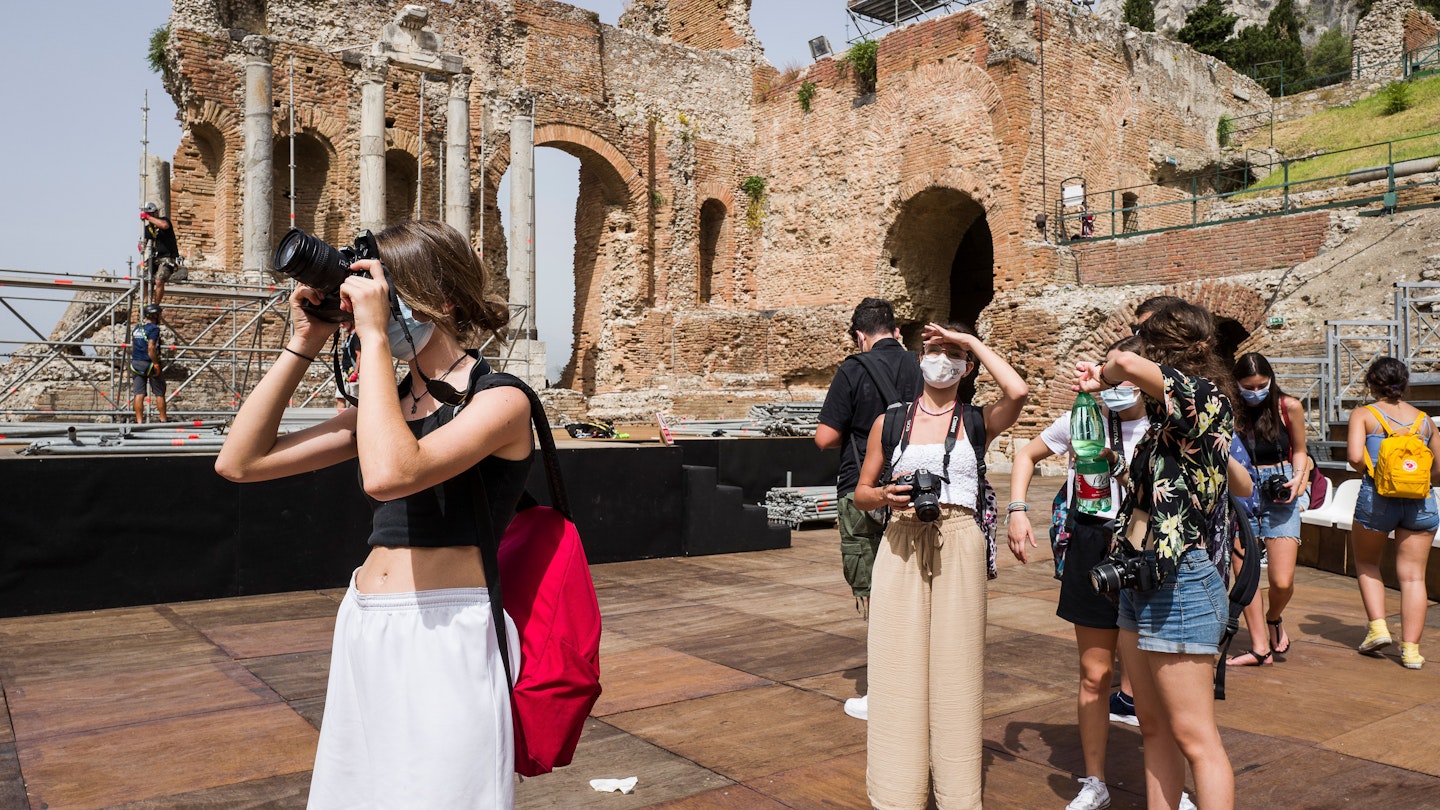
Tourists return to the Teatro Antico in Taormina, Sicily as Italy relaxes border and domestic restrictions © Fabrizio Villa/Getty Images
Italy has gradually relaxed border controls and most restrictions as travelers return to one of the world's most popular destinations. And while there are plenty of new attractions to enjoy, from newly-opened secret tunnels in the Colosseum to recent discoveries in Pompeii , it isn't business as usual. Italy is still in a state of emergency and some pandemic-related restrictions apply, including the requirement of a green pass to enter indoor venues and large events.
With the ongoing threat of the Delta variant, travelers are warned that increased measures could be enforced with little notice. If you're planning a trip to Italy this year, here's what you can expect.
Can I travel to Italy from the EU?
Italy has adopted the EU digital COVID certificate which facilitates the return of free movement across the bloc. It's a digital or paper certificate that indicates the holder meets the conditions for travel: is fully vaccinated (the last dose administered at least 14 days before departure), or has recovered from COVID-19, or holds a negative COVID-19 result from a PCR or antigen test taken within 48 hours of travel.
Read more: Planning your perfect trip to Italy's Amalfi Coast
You will need to present this cert to enter Italy, regardless of where you are traveling from in the EU. That's because Italy does not classify risk areas in accordance with the EU's recommendations and currently no country is classified as low risk. So even if you are coming from an EU country that is classified green (low risk) in the European Center for Disease Prevention and Control’s traffic light system, you are still required to present a digital COVID cert to travel to Italy.
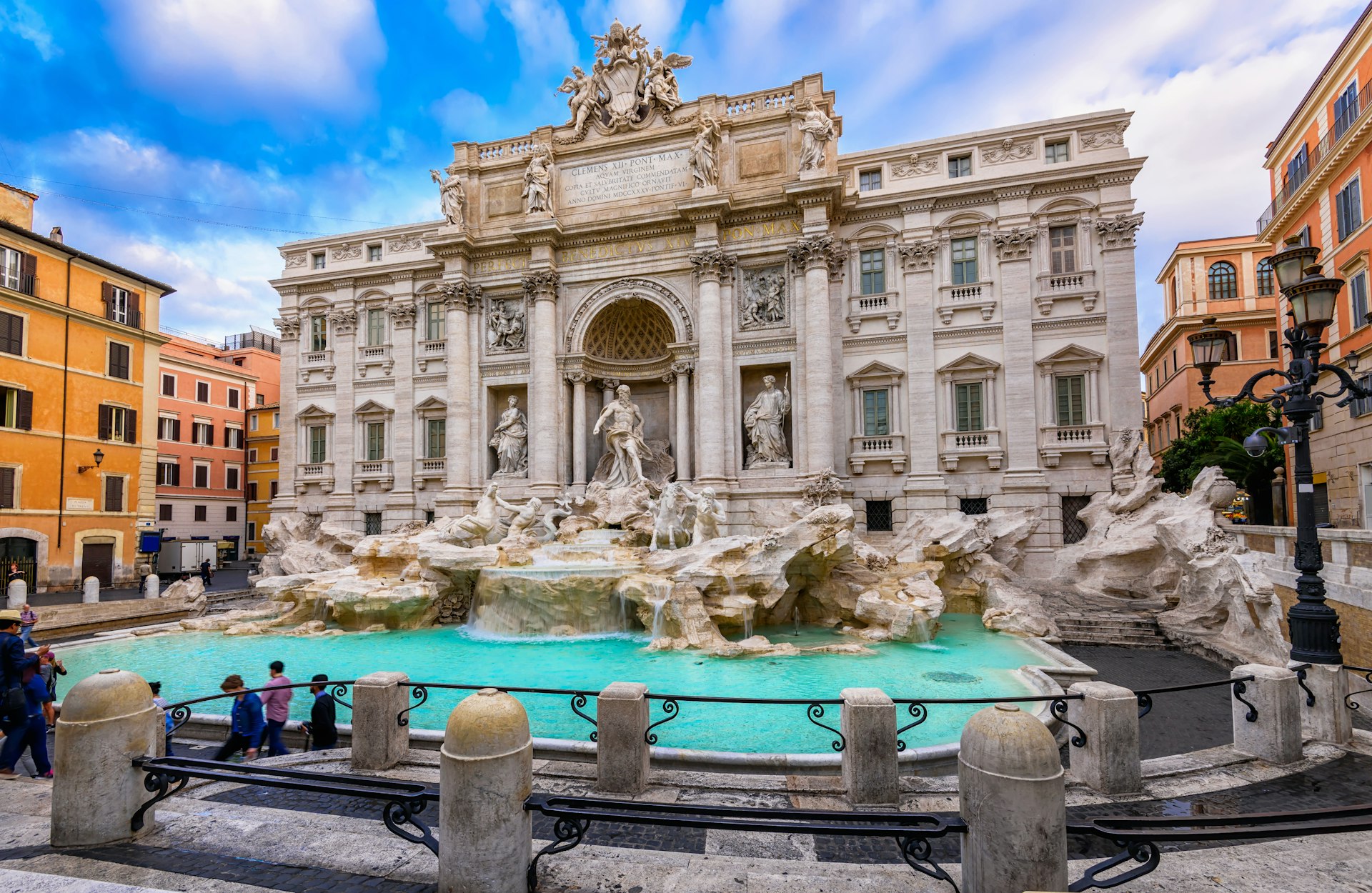
Can I travel to Italy from a non-EU country?
Italy applies border restrictions on travelers depending on the COVID situation in the country they are departing from. Most countries are on the C and D list and quarantine restrictions apply to all of them except for the US, Canada, Japan and Israel . People arriving from those countries are permitted to skip quarantine provided they present proof of vaccination, proof of recovery from COVID-19, or a negative result from a test taken no more than 72 hours before traveling to Italy, using official vaccination or medical documents issued in either of those countries.
Those arriving from the UK will have to undergo a five-day quarantine upon arrival with mandatory testing until at least August 30.
Entry restrictions for individual countries can be found here .
What vaccines does Italy accept?
Italy requires that travelers are fully vaccinated with both doses of an EMA-approved vaccine: Pfizer, Moderna, or AstraZeneca; or with the one-shot Johnson & Johnson vaccine.
Do children need to be vaccinated to enter Italy?
Children under six-years-old are exempt from all vaccine, testing or quarantine requirements in Italy. However, children between the age of six and 18 are required to present a negative COVID-19 test result before arrival.
What else is required?
All arrivals are required to fill in a passenger locator form before arrival, regardless of their COVID status or point of departure.

Do I need a green pass in Italy?
Yes, if you want to enjoy most of Italy's cultural attractions, you'll need a green pass. The pass proves that the holder has been vaccinated, has recovered from COVID-19 or has recently tested negative for the virus. People need to present it to enter indoor spaces such as museums, football stadiums, gyms, theme parks, spas, swimming pools and theaters. It's also required to sit indoors at bars and restaurants; and from September 1, it will be required to board public transport in Italy.
Anyone traveling from another EU country, can present their EU digital COVID cert wherever the green pass is required. People traveling from a Schengen Zone country can present their official health documents too.
The Italian government confirmed that it will accept official COVID documents that were issued in Canada, the US, the UK, Japan and Israel from tourists too in place of a green pass. This was later extended to cover all official vaccination certificates that are compliant with Italian or EU guidelines. In order for it to be accepted in lieu of the green pass, the certificate must be in Italian, English, Spanish or French and contain the following information: type of vaccine (Pfizer, Moderna, J&J or AstraZeneca), date of doses and lot number, as well as the person's name and the name of the medical authority issuing the certificate.However, despite the guidelines, some tourists have reported difficulty with having their certificates accepted at venues.
If you're not vaccinated, you'll need to be tested via a PCR or antigen test within the previous 48 hours.
Read more: Italy has expanded the use of it 'green pass' - here's what travelers need to know
Can I get tested in Italy?
Many countries, including the US, require passengers to present a negative COVID-19 test result before boarding their flight home from an international trip. Fortunately, tests are widely available across Italy in pharmacies, labs and testing centers. Antigen tests cost approximately €20, while PCR tests are generally around €65.
The Red Cross has pop-up testing sites in train stations across Italy , including Roma Termini, Milano Centrale, Venice Santa Lucia and Florence Santa Maria Novella for antigen tests. On-site testing is available at Italy's major airports too, and most offer both antigen and PCR tests but check the website of the airport you are traveling through in advance for details.
Read more: Italy visa requirements
What's open in Italy?
Italy is home to many of the world's greatest works of art, architecture and gastronomy, and has more Unesco World Heritage cultural sites than any other country. Among its popular attractions are Pompeii , where visitors can walk in the footsteps of ancient Romans, and Ravenna , home to glittering Byzantine treasures. The gondolas of Venice take in the famous Rialto Bridge , while Rome is home to St Peter's Basilica, the Vatican Museums and the Colosseum, as well as the iconic Trevi Fountain.
Thankfully, you can experience these sites with relative ease as all Italian regions are now classified as "white zones". Italy classifies its regions into colored areas based on the epidemiological risk; different restrictions apply, depending on the color. White zones are very low-risk zones. Most restrictions have been lifted but social distancing guidelines remain in place in public areas, as do mask requirements in crowded outdoor places, on public transport and in indoor public spaces.
Indoor dining has returned to Italy's restaurants, cafes, bars, ice-cream parlours and pastry shops. Some capacity limits apply but the general rule is no more than six people per table. Anyone who wishes to eat inside will need to show proof of vaccination, recovery from COVID-19 or a recent negative test. Hotels, spas and swimming pools are open, as well as beaches but visitors must keep at least one meter apart when setting up towels, deck chairs or umbrellas.
Museums and cultural attractions are open for walk-ins with capacity limits Monday to Friday and for those with pre-booked tickets on weekends. Cinemas, theaters and concert halls are generally open at 50% capacity. Again, remember to bring your vaccination card if you're planning to visit any museum or cultural attraction in Italy.
For a full breakdown of restrictions per region, see here .
This article was first published on May 5 and updated on August 23, 2021.
You might also like:
Eat Italy: learn about Italian food culture with Lonely Planet's new book 12 essential places to visit in Italy The 10 best beaches in Italy
This article was first published May 2020 and updated August 2021
Explore related stories
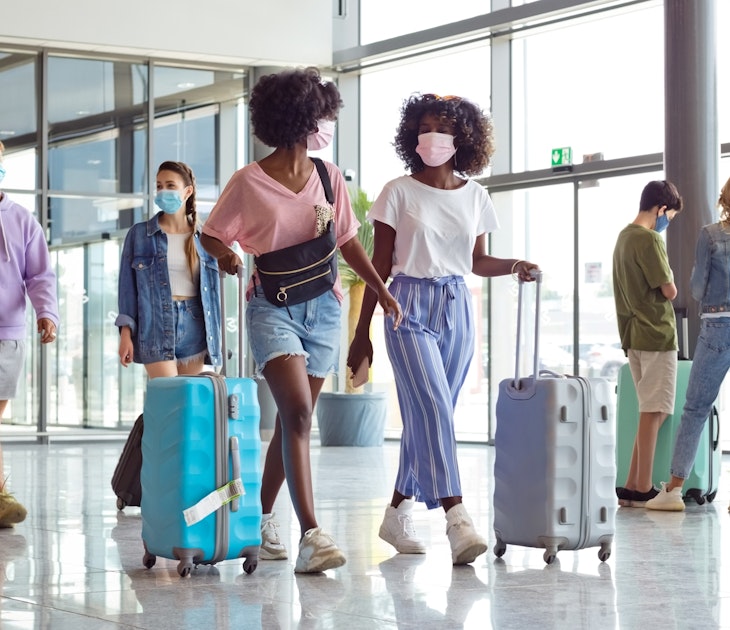
May 16, 2022 • 4 min read
The policy changes on May 16, but there are still many countries who require passengers to keep masks on during flights.

May 10, 2022 • 4 min read

May 4, 2022 • 3 min read

Apr 29, 2022 • 2 min read

Apr 22, 2022 • 3 min read

Mar 31, 2022 • 9 min read

Feb 24, 2022 • 2 min read

Feb 18, 2022 • 3 min read

Feb 3, 2022 • 3 min read

Jan 18, 2022 • 7 min read
We’re sorry, this site is currently experiencing technical difficulties. Please try again in a few moments. Exception: request blocked
- Useful tips
Planning your trip to Italy: restrictions due to Covid-19
The state of emergency, due to the spread of the COVID-19 virus, on Italian territory has been extended until 31 December 2021. The government has updated Italy travel restrictions , extending them until December and updating some of them.
Covid-19 updates: information for tourists
Italy applies health restrictions to incoming travellers , which may vary depending on the country of origin. The Italian government’s order continues to be based on five lists of countries, for which different measures are planned. Below there are the disposals to be followed to enter Italy .
- A List : San Marino and Vatican City. Right now, there are no travel restrictions for List A states and territories.
- B List : States and territories at low epidemiological risk. Currently, no state is on this list.
- C List : Austria, Belgium, Bulgaria, Cyprus, Croatia, Denmark (including the Faroe Islands and Greenland), Estonia, Finland, France (including Guadeloupe, Martinique, Guyana, Reunion, Mayotte and excluding other territories outside the European mainland), Germany, Greece, Ireland, Latvia, Lithuania, Luxembourg, Malta, Netherlands (excluding territories located outside the European continent), Poland, Portugal (including Azores and Madeira), Czech Republic, Romania, Slovakia, Slovenia, Spain (including territories in the African continent), Sweden, Hungary, Iceland, Norway, Liechtenstein, Switzerland, Andorra, Monaco. According to Italian law, travel from list C countries is permitted without the need to state reasons.
- D List : Saudi Arabia, Australia, Bahrain, Canada, Chile, United Arab Emirates, Japan, Jordan, Kosovo, Israel, Kuwait, New Zealand, Qatar, Rwanda, United Kingdom of Great Britain and Northern Ireland (including Gibraltar, Isle of Man, Channel Islands, British bases on the island of Cyprus), Republic of Korea, Singapore, United States of America, Ukraine, Uruguay, Taiwan, Hong Kong Special Administrative Regions and Macau. Under Italian law, all movements from these countries are permitted.
- E List : Rest of the world, all states and territories not expressly listed elsewhere. Travel to Italy from all List E countries is permitted only for specific reasons: work, health, study, absolute urgency, return to domicile, home or residence. Therefore, travel for tourism to List E countries is not permitted.
- Covid-free tourist corridors : Health Minister Roberto Speranza has signed an order establishing – on an experimental basis and with precise safety protocols – COVID-free travel corridors for non-EU tourist destinations. The travel corridors are operational for Aruba, Maldives, Mauritius, Seychelles, Dominican Republic, Sharm El Sheikh and Marsa Alam.
Requirements for entry into Italy
Travellers from these countries can enter Italy without quarantine , provided that:
- Have fill out the Passenger Located Form (PLF) before entering Italy. Here you can find the Passenger Locator Form.
- On arrival, present the COVID-19 Green Pass or the certificate issued by your country’s health authority confirming full vaccination against COVID-19, carried out at least 14 days beforehand, using a vaccine recognised by the European Medicines Agency (EMA). Green Passes must be in Italian, English, French or Spanish and can be submitted in digital or paper format.
- Present a document certifying that they have carried out a molecular or antigenic swab within 48 hours prior to arrival in Italy with negative results.
Travellers who do not present such documentation on entry into Italy may still enter the country, but they must undergo a 5-day quarantine and they must inform the Prevention Department of the competent Local Health Authority. After 5 days of isolation, they must perform an additional molecular or antigenic test.
You can find out the conditions of entry to Italy from your country with a few clicks on viaggiaresicuri.it
Tampon exentions for infants and children under 18 years old
Children under 6 years of age are not required to present proof of negative molecular or antigenic tests on entry into Italy, but they must comply with the isolation requirement when requested.
People under 18 years of age are exempt from the isolation requirement (where applicable) only if they are accompanied by an adult (parent or other accompanying person) holding a Green Pass.
Anti-Covid measures in Italy
To ensure the safety of residents and tourists, the Italian government has introduced a classification of regions based on colours : white (minimum risk), yellow, orange and red (maximum risk). Right now, Italy is all in white zone.

Mask and distancing
Wearing a mask is still compulsory in indoor public places throughout Italy, while they are no longer obligatory outdoors. Children under 6 years of age and disabled persons and their carers are not obliged to wear a mask. It is always advisable to keep a safe distance of one metre from other people and to wash or sanitize hands often.
Local public transportation
Local public transport (buses, metro, trams, etc.) can carry a maximum of 80% passengers. The green COVID-19 pass is not required to use these means of transport.
Cafés and restaurants
Every restaurants o cafés must display a sign indicating the maximum number of people allowed inside simultaneously. Consumption at the table is always permitted, but all persons over the age of 12 must present the COVID-19 digital green certificate for consumption at the table indoors.
Museums and cultural sites
Museums and other cultural sites are open. Before planning a visit, we advise you to call or consult the institutional websites of the museums where the access rules are published (they may vary from museum to museum). All visitors over the age of 12 must show their COVID-19 green digital certificate at the entrance.
Cinemas, theatres and concerts
There are no limits on indoor and outdoor capacity, but people over 12 years old must show their Green Pass.
Sports events
The sports events are open to the public with a maximum capacity of 75% outdoors and 60% indoors, but entry is only permitted with Green Pass.
Discos are open to the public, with a maximum capacity of 75% outdoors and 50% indoors, but even here entry is only permitted by showing the Green Certificate.
New restrictions due to the Omicron variant
After the increase of infections (with the arrival of the fourth wave) and the discovery of the Omicron variant , many countries are adapting their internal security measures and increasing restrictions, especially for those arriving from abroad.
In the run-up to the Christmas and New Year holidays, many people have already booked, or are in the process of booking, their holidays in Italy.
Here, then, there is the updated guide on what you need to do before you leave and when you arrive in a foreign country, based on Ministry of Foreign Affairs notices and Ministry of Health orders (sites that you should always check before leaving).
In Italy , there are currently no travel and travel restrictions between regions, nor are there any plans to do so. It is only if a region were to enter the red zone that travel restrictions would be in force for everyone. At the moment, however, not only are there no regions in the red zone and not even in the orange zone; only Friuli Venezia Giulia is in the yellow zone.
Entry to Italy is currently prohibited for those who have been in South Africa, Lesotho, Botswana, Zimbabwe, Mozambique, Namibia, Eswatini, Malawi in the last 14 days . For all others, the rules remained the same.
New restrictions updated to 15 December 2021
The new order by Health Minister Speranza, valid from 16 December to 31 January, concerns those who decide to travel to Italy .
The ordinance requires a negative test on departure for all arrivals from EU countries, even for those who are vaccinated . A negative molecular swab carried out within 48 hours before entry into Italy or an antigenic swab within 24 hours before entry into Italy will therefore be required. For unvaccinated persons, a five-day quarantine is required in addition to a negative test.
For those arriving from non-EU countries , the duration of quarantine is ten days if they are not vaccinated. If you are vaccinated, you must take a molecular test 72 hours before entry or an antigenic test 24 hours before entry. If you arrive from Great Britain and Northern Ireland , the molecular test must be carried out within 48 hours prior to entry.
It remains possible to travel abroad safely for tourism purposes via the Covid free corridors operating to Aruba, Maldives, Mauritius, Seychelles, Dominican Republic, Sharm El Sheikh and Marsa Alam.
On the other hand, the ban on entry was extended until 31 January for those arriving from South Africa, Lesotho, Botswana, Zimbabwe, Malawi, Mozambique, Namibia and Swatini.
New restrictions updated to 23 December 2021
With the increase in infections come new restrictions on travel and entry into Italy.
With the new decree, the obligation to present a negative swab for those entering the country has been reintroduced in Italy until 31 January 2022, even for those who have been vaccinated. This also applies to those arriving from EU member states. The negative swab may be a molecular swab taken within 48 hours prior to entry, or an antigenic swab taken within 24 hours prior to entry. The presentation of the swab, together with the Green Pass and the Passenger Locator Form , allows you not to undergo fiduciary isolation.
The situation is different for unvaccinated persons : in addition to submitting a negative swab result (molecular or antigenic), unvaccinated persons will have to observe five days of fiduciary isolation with the obligation to be swabbed at the end of quarantine.
Among the new safety measures adopted by Italy is the obligation to wear masks outdoors , even in the white zone. But even more important is the obligation to wear FFP2 masks in cinemas, theatres, museums, events (both indoors and outdoors), as well as on means of transport. In addition, the consumption of food and drink is prohibited in all indoor places.
The new provisions prohibit any demonstration, event or festivity involving an assembly, whether in outdoor or indoor spaces, until 31 January 2022.
In the Decree from 30 December, access to museums, swimming pools, gyms, health centres and spas, amusement arcades, bars and restaurants (also outdoors), religious ceremonies, cultural events and trade fairs requires a Super Green Pass : the certificate issued to vaccinated and cured people. The ‘basic’ certificate, which is issued to those with a negative swab, is no longer sufficient.
All rights reserved © Copyright Altrama Italia
- Facebook icon Facebook
- Twitter icon Twitter
- Pinterest icon Pinterest
Filed under
- Useful tips 2
Leave a Reply Cancel reply
Your email address will not be published. Required fields are marked *
Save my name, email, and website in this browser for the next time I comment.
Username or Email Address
Remember Me
- Skip to main content
- Keyboard shortcuts for audio player
A day trip to Venice will require a reservation — and a fee
The Associated Press
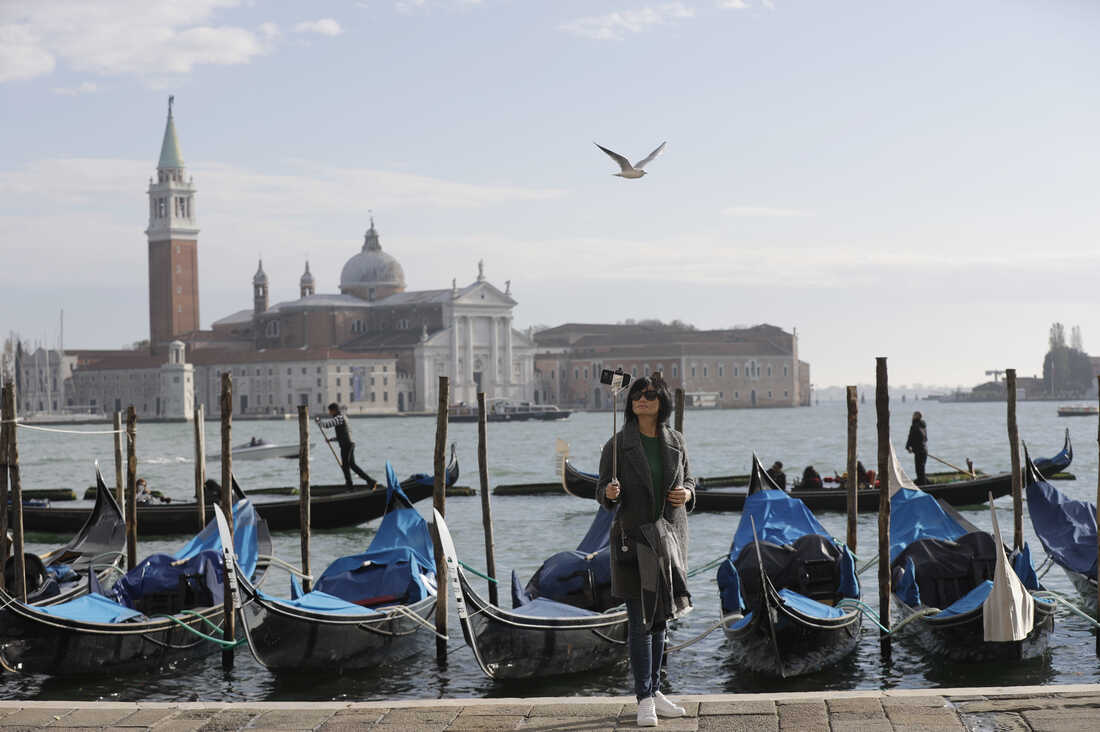
A tourist takes a selfie in St. Mark's Square in Venice, Italy, in 2016. Starting in January, the city will require day-trippers to make reservations and pay a fee to visit. Luca Bruno/AP hide caption
A tourist takes a selfie in St. Mark's Square in Venice, Italy, in 2016. Starting in January, the city will require day-trippers to make reservations and pay a fee to visit.
ROME — Starting in January, Venice will oblige day-trippers to make reservations and pay a fee to visit the historic lagoon city, in a bid to better manage visitors who often far outnumber residents in the historic center, clogging narrow streets and heavily-used foot bridges crossing the canals.
Venice officials on Friday unveiled new rules for day-trippers, which go into effect on Jan. 16, 2023.
Tourists who choose not to stay overnight in hotels or other lodgings will have to sign up online for the day they plan to come and pay a fee. These range from 3 to 10 euros ($3.15 to $10.50) per person, depending on advance booking and whether it's peak season or the city is very crowded.
Transgressors risk fines as high as 300 euros ($315) if stopped and unable to show proof they booked and paid with a QR Code.

From the archives
With waters rising and its population falling, what is venice's future.
Roughly four-fifths of all tourists come to Venice just for the day. In 2019, the last full year of tourism before the pandemic, some 19 million day-trippers visited Venice and provided just a fraction of the revenue from those staying for at least one night.
Venice's tourism commissioner brushed off any suggestion that the measure would seek to limit the number of out-of-towners coming to Italy's most-visited city.
"We won't talk about number cutoffs. We're talking about incentives and disincentives," Simone Venturini told a news conference in Venice.

Tourists stroll in downtown Venice in 2016. On many days, the heart of the city is overwhelmed by visitors, who often far outnumber residents. Luca Bruno/AP hide caption
Tourists stroll in downtown Venice in 2016. On many days, the heart of the city is overwhelmed by visitors, who often far outnumber residents.
The reservation-and-fee approach had been discussed a few years ago, but was put on hold during the pandemic. COVID-19 travel restrictions saw tourism in Venice nearly vanish — and let Venetians have their city practically to themselves, for the first time in decades.
Mass tourism began in the mid-1960s. Visitor numbers kept climbing, while the number of Venetians living in the city steadily dwindled, overwhelmed by congestion, the high cost of delivering food and other goods in car-less Venice, and frequent flooding that damages homes and businesses.
Since guests at hotels and pensions already pay a lodging tax, they are exempt from the reserve-and-fee obligation.
With the new rule, Venice aims to "find this balance between (Venetian) resident and long-term and short-term" visitors, Venturini said, promising that the new system "will be simple for visitors" to manage. He billed Venice as the first city in the world putting such a system for day-only visitors in place.

As tourists crowd out locals, Venice faces endangered' list
The tourism official expressed hope that the fee-and-reservation obligation will "reduce frictions between day visitors and residents." In peak tourism system, tourists can outnumber residents 2-to-1, in the city that measures 5 square kilometers (2 square miles) in area.
Venice's resident population in the historic city numbers just over 50,000, a small fraction of what it was a couple of generations ago.
Exceptions to the day-tripper fees include children younger than 6, people with disabilities and those owning vacation apartments in Venice, provided they can show proof they pay real estate taxes.
Cruise ships contribute to the hordes of visitors swarming Venice's maze of narrow streets, especially near St. Mark's Square, when they disembark day-trippers for a few hours. Those visitors will have to pay, too, unless their cruise liner company pays a set fee to Venice.
clock This article was published more than 1 year ago
Everything you need to know about traveling to Italy

For Aldo Melpignano, co-founder of the luxury hotel Borgo Egnazia in Italy’s Puglia region, the country’s reopening is palpable in the piazza, where people dance while local musicians play.
His hotel had reimagined its operations during the pandemic, hosting dinner parties with spaced-out tables. But he recently saw guests get up and move to the music again at an event in late April — and even danced with them.
“It’s refreshing and makes you feel like we’re back, and sort of almost forgot about all that’s happened the last couple years,” he said.
Like destinations around the world, Italy has relaxed many of its covid restrictions , and Melpignano and other Italian travel experts are gearing up for a busy summer. “In terms of tourism here in Italy, it’s definitely back on,” Clio Morichini, head of travel and events for Italy Segreta , said in an email.
If you’re thinking about visiting this summer, here’s what you need to know before you go.
How to get there
As of June 1, Italy has lifted all its pandemic-era entry restrictions , no longer requiring international travelers to show proof of vaccination, proof of recovery from the coronavirus or a negative test.
Italy requires travelers to wear FFP2-grade masks on planes. Despite the European Union ending a mask mandate for air travel, Italy will keep its rule in place until June 15.
Elizabeth Minchilli, an author and food tour operator who lives in Rome and has a vacation home in Umbria, said your airline’s website is typically your best source of information regarding any remaining rules.
A local's guide to Rome
How to show your vaccination status
Italy discontinued the use of its Green Pass — which captured proof of vaccination, recovery from covid or a negative test result — for most indoor settings this month. The pass is no longer required for many places including restaurants, bars, museums, theaters, spas and gyms. However, it is still mandatory for others, like hospitals and nursing homes.
Some tour operators such as Minchilli, are also asking customers to be vaccinated before being allowed to join group excursions.
How to dine and explore
You may have competition finding a seat, room, ticket or beach chair this summer. Simone Amorico, CEO of the private tour operator Access Italy , estimates that his company’s bookings are up about 40 percent from 2019.
He advised travelers to plan ahead by booking hotels and activities two months in advance. “I mean, the sooner the better, but two months is a good bracket,” he said.
Even so, Amorico said, during a visit to Rome’s Colosseum last week, he noticed shorter lines now that guests do not need to present a Green Pass.
Minchilli said the Italian capital is already packed. “It’s hard to drive through the streets, there are so many people wandering around,” she said. “But that’s normal for May and June … For those of us who lived the last two years in Rome, it’s sort of shocking because we got kind of used to it being empty. But now, things are starting to get back to normal, which is a good thing.”
Her tours are fully booked through 2023, though she is adding more next year.
Annabella Cariello, general manager of Hotel Vilòn in Rome, also advised purchasing train and ferry tickets ahead of time and making reservations when going out to eat. She said the situation is much different from last fall or summer.
“I think that we have indeed switched gears and are ready to bring back our Italian-ness and celebratory approach. … The atmosphere is rather festive as the weather is getting better and we see summer just around the corner,” she said in an email.
In southeast Italy, this pastry is king
What to know about restrictions
Morichini said by email that while coronavirus case numbers are relatively high, many restrictive measures have been “removed or softened and life is slowly and gradually going back to normality.” Italy saw a 12 percent drop in daily cases over the past seven days, with 22.85 reported cases per 100,000 people reported Monday, according to tracking data compiled by The Washington Post.
That number is higher than this time last year but represents a dramatic decrease from counts during the omicron wave, which saw 378.33 reported cases per 100,000 people on Jan. 18. Daily deaths also dropped 10 percent over the past week.
While Italy dropped its indoor mask rule this month for most places, masks are still recommended indoors and at crowded outdoor events. In addition to airports and public transportation, FFP2 face coverings are also still required at indoor sporting events, cinemas and concert halls.
Minchilli gives her guests a pack of masks to wear out of consideration for staff at businesses such as stores and restaurants. “I suggest that if you walk in and somebody working in a place is wearing them, you might want to put them on just in respect of that person,” she said.
As the world battles the spread of coronavirus variants , too, remember that mandates and restrictions may change at any time.
Where to get a coronavirus test before returning home
While the testing requirement to return to the United States has dropped, you may still want to test before your flight home.
PCR tests cost about $70, and antigen tests run about $20, according to the U.S. Embassy and Consulates in Italy.
You should still test for travel, health experts say
Melpignano — who is also vice president of the Altagamma, a foundation that represents high-end Italian cultural and creative companies — says most upscale hotels will arrange tests for guests to make life easy.
Amorico said test-seeking travelers can find them at Italian pharmacies. Otherwise, instead of finding a test locally, travelers can pack an at-home test with a video option to test in front of a provider, such as the Abbott BinaxNOW kit, to take themselves within that one-day window.
In case you do test positive for the coronavirus while you’re in Italy, Melpignano, Minchilli and Amorico all recommend getting covid-specific travel insurance . You should check whether your health-insurance plan covers issues abroad, too.
Those who test positive will need to self-isolate for seven to 21 days, depending on the circumstances, and will be on the hook for the cost, per the U.S. Embassy and Consulates in Italy.
Otherwise, while you’re there, have fun. Minchilli said there is a positive energy right now, from locals and tourists alike: “Even when you’re in a crowded piazza in Rome, you can just feel how happy everybody is."
Natalie Compton contributed to this report.
More travel tips
Vacation planning: Start with a strategy to maximize days off by taking PTO around holidays. Experts recommend taking multiple short trips for peak happiness . Want to take an ambitious trip? Here are 12 destinations to try this year — without crowds.
Cheap flights: Follow our best advice for scoring low airfare , including setting flight price alerts and subscribing to deal newsletters. If you’re set on an expensive getaway, here’s a plan to save up without straining your credit limit.
Airport chaos: We’ve got advice for every scenario , from canceled flights to lost luggage . Stuck at the rental car counter? These tips can speed up the process. And following these 52 rules of flying should make the experience better for everyone.
Expert advice: Our By The Way Concierge solves readers’ dilemmas , including whether it’s okay to ditch a partner at security, or what happens if you get caught flying with weed . Submit your question here . Or you could look to the gurus: Lonely Planet and Rick Steves .
- A local’s guide to Washington, D.C. January 30, 2024 A local’s guide to Washington, D.C. January 30, 2024
- MGM, Caesars casino hacks point to an alliance of teens and ransomware gangs September 22, 2023 MGM, Caesars casino hacks point to an alliance of teens and ransomware gangs September 22, 2023
- A local’s guide to Copenhagen June 23, 2022 A local’s guide to Copenhagen June 23, 2022

Italy Travel Restrictions: What Travelers Need To Know
Italy was one of the first countries to be hit hard by the coronavirus pandemic and has subsequently worked hard to get the disease under control. At this point, the country has largely reopened, which means that travelers can enjoy the fantastic food, culture, and history that makes Italy such an electric destination.
No one knows a place like the people who live there. For the most up-to-date info on Italy travel, connect with an Italian local. Learn more .
Table of Contents
Is it safe to travel to italy right now, italy travel restrictions to know before your arrival, what to expect on a trip to italy.
- Why Travel To Italy Right Now
- Work With A Local To Plan Your Trip To Italy
As COVID travel restrictions go, Italy has lifted most of them and travel feels much like it did pre-pandemic. But is Italy safe to visit ?
When the coronavirus pandemic first emerged in 2020, it hit Italy especially hard with a devastating first wave in March 2020. Like most places, Italy has seen more waves of COVID over the past few years. But strict travel restrictions and a vaccination campaign that has resulted in 80% of the country fully vaccinated as of September 2022 have helped keep the virus at bay as much as possible.
At this point, the CDC gives Italy a Level 3 rating , which means that cases are high. They recommend that all travelers get vaccinated before going to Italy .
So what kind of COVID travel policies does Italy have in place? And what should travelers expect when they arrive in cities like Rome , Venice , or Naples ?
Both vaccinated and unvaccinated travelers may visit Italy (although the CDC recommends vaccination before travel). Neither vaccinated nor unvaccinated travelers need to present a negative COVID test.
Right now, the only nationwide requirement to keep in mind is that FFP2 masks are required on public transportation and in healthcare settings. Individual businesses are also allowed to require masks at their discretion.
Travel in Italy feels almost like it did pre-COVID. More people wear masks (and they’re still required in some places). It’s smart to pack COVID rapid tests and be mindful of the local case levels. If you happen to get COVID during your trip, you’ll need to self-isolate for 5 - 14 days .
But day to day, you can take a passeggiata in the evenings, go for a cappuccino at a corner cafe in the mornings, visit museums, and enjoy long leisurely meals like you could before the pandemic.
That said, things could change at any time and it’s important for travelers to respect local rules and regulations. We recommend checking in with a local on the ground to learn about current Italy travel restrictions and get the best tips on things to do in Italy.
Why Travel To Italy Right Now
Things to do in Italy range from exploring the rich history in Rome to feasting on seafood in Venice, soaking in the art scene in Florence, or simply sitting down and ordering some handmade pasta.
Plus, you’ll find some fantastic places to stay in Italy . If you love old cities, history, and good food, you can’t beat going to Rome. If you’re looking for rolling countryside and heart-stopping sunsets, then maybe you’ll want to go to Tuscany. Then again, it’s hard to beat the glitz and glam of Milan .
All in all, travelers will still be able to plan an Italy trip that fits their travel style. If you’re looking to get out of the cities and avoid crowds, Italy has tons of places to visit that you’ll like. But if you’re ready to see the world again and dive into an Italian city, then you can find that, too.
Work With A Local To Plan Your Trip To Italy
No one knows a place like the people who live there. Local knowledge can always enrich a trip, but it’s especially crucial at a time when covid travel restrictions are in flux.
So as you plan your trip to Italy, reach out to an Italian local . They can help explain what you should expect when you visit their hometown.
Of course, that means that they can let you know about things like mask mandates. But they can also tell you which restaurants are still open, which ones from online “top ten” lists have closed, which places locals love, and what places have good outdoor seating.
Basically, they can let you know what it’s like in Italy right now . And they can help you plan a trip that fits your travel style and your risk tolerance.
Ready to have a local plan your trip to Italy? Connect with a local today to learn more.
Curious about other destinations? Check out our articles COVID-19 travel restrictions in Puerto Rico , Portugal , Spain , Costa Rica , France , and Cuba . Or better yet, talk to a local in the destination you want to visit.
Looking for more info?
Update April 12, 2024
Information for u.s. citizens in the middle east.
- Travel Advisories |
- Contact Us |
- MyTravelGov |
Find U.S. Embassies & Consulates
Travel.state.gov, congressional liaison, special issuance agency, u.s. passports, international travel, intercountry adoption, international parental child abduction, records and authentications, popular links, travel advisories, mytravelgov, stay connected, legal resources, legal information, info for u.s. law enforcement, replace or certify documents.
Share this page:
Italy Travel Advisory
Travel advisory july 26, 2023, italy - level 2: exercise increased caution.
Reissued with obsolete COVID-19 page links removed.
Exercise increased caution due to terrorism .
Country Summary: Terrorist groups continue plotting possible attacks in Italy. Terrorists may attack with little or no warning, targeting tourist locations, transportation hubs, markets/shopping malls, local government facilities, hotels, clubs, restaurants, places of worship, parks, major sporting and cultural events, educational institutions, airports, and other public areas.
Read the country information page for additional information on travel to Italy.
If you decide to travel to Italy:
- Be aware of your surroundings when traveling to tourist locations and crowded public venues.
- Follow the instructions of local authorities.
- Monitor local media for breaking events and adjust your plans based on new information.
- Enroll in the Smart Traveler Enrollment Program ( STEP ) to receive Alerts and make it easier to locate you in an emergency.
- Follow the Department of State on Facebook and Twitter .
- Review the Country Security Report for Italy.
- Visit the CDC page for the latest Travel Health Information related to your travel.
- Prepare a contingency plan for emergency situations. Review the Traveler’s Checklist.
Travel Advisory Levels
Assistance for u.s. citizens, search for travel advisories, external link.
You are about to leave travel.state.gov for an external website that is not maintained by the U.S. Department of State.
Links to external websites are provided as a convenience and should not be construed as an endorsement by the U.S. Department of State of the views or products contained therein. If you wish to remain on travel.state.gov, click the "cancel" message.
You are about to visit:
Cookies on GOV.UK
We use some essential cookies to make this website work.
We’d like to set additional cookies to understand how you use GOV.UK, remember your settings and improve government services.
We also use cookies set by other sites to help us deliver content from their services.
You have accepted additional cookies. You can change your cookie settings at any time.
You have rejected additional cookies. You can change your cookie settings at any time.
- Passports, travel and living abroad
- Travel abroad
- Foreign travel advice
Warnings and insurance
This travel advice page also covers the Vatican City.
The Foreign, Commonwealth & Development Office ( FCDO ) provides advice about risks of travel to help British nationals make informed decisions. Find out more about FCDO travel advice .
Before you travel
No travel can be guaranteed safe. Read all of the advice in this guide and and any specific travel advice that applies to you:
- women travellers
- disabled travellers
- LGBT+ travellers
Follow FCDO travel on, Twitter , Facebook and Instagram . You can also sign up to get email notifications when this advice is updated.
Travel insurance
If you choose to travel, research your destinations and get appropriate travel insurance . Insurance should cover your itinerary, planned activities, and expenses in an emergency.
Related content
Is this page useful.
- Yes this page is useful
- No this page is not useful
Help us improve GOV.UK
Don’t include personal or financial information like your National Insurance number or credit card details.
To help us improve GOV.UK, we’d like to know more about your visit today. We’ll send you a link to a feedback form. It will take only 2 minutes to fill in. Don’t worry we won’t send you spam or share your email address with anyone.
Italy launched its long-awaited 'digital nomad visa' — here's who qualifies and how to apply
- It just got much simpler for remote workers to move to Italy .
- Non-EU or Swiss citizens can now apply for a digital nomad visa that lasts for one year.
- Here are the requirements.

Italy is welcoming globetrotting professionals with open arms.
The country's digital nomad visa went into effect last week after being discussed by Italian legislators for years, and it's aimed at remote workers who want to spend some time living in the popular European destination, according to Euronews .
The Italian government defines digital nomads as non-European Union or Swiss citizens who are highly skilled, Euronews said. They should be able to work remotely, either as someone self-employed or in collaboration with or as an employee of a company.
Related stories
But it's not as simple as showing up with your luggage and laptop.
Visa applicants must earn three times the minimum level required for exemption from participation in healthcare costs. That comes out to just under €28,000 annually or about $30,400.
Further requirements include health insurance coverage for the duration of your stay, proof of accommodation, and candidates will have to show they've been a remote worker elsewhere for at least six months or a digital nomad for the same period of time.
And while the digital nomad visa is only good for one year, it can be renewed — and your family can be included.
You may, however, get rejected if you've been convicted of a crime in the last five years, Euronews said.
It's the latest effort from Italy to encourage growth. For a while now, aging Italian towns have offered their homes up for just one euro in an effort to curb underpopulation. The deal attracted foreigners who took advantage of the fixer-uppers.
Still, elsewhere in Europe, several countries are rolling back their "golden visas" that once allowed outsiders to obtain residency permits after investing over $500,000 in real estate.
Watch: Migrants who died in Italy shipwreck paid 8,000 euros each
- Main content
Language selection
- Français fr
Minister Joly to travel to Italy and the Holy See for bilateral visit and G7 Foreign Ministers’ Meeting
From: Global Affairs Canada
News release
The Honourable Mélanie Joly, Minister of Foreign Affairs, today announced that she is travelling to Italy and the Holy See and will be in Rome on April 16 and in Capri from April 17 to 19.
April 15, 2024 - Ottawa, Ontario - Global Affairs Canada
While in Rome, Minister Joly will meet with her Italian counterpart Antonio Tajani, Deputy Prime Minister and Minister of Foreign Affairs and International Cooperation, to exchange views on ongoing global challenges, including in the Middle East, Ukraine and the Indo-Pacific region, as well as to explore opportunities for coordinated efforts to advance mutual priorities. They will also discuss opportunities to strengthen the two countries’ bilateral relationship through the Canada-Italy Roadmap for Enhanced Cooperation, announced in March by Prime Minister Justin Trudeau and Italian Prime Minister Giorgia Meloni.
She will also meet with Cardinal Pietro Parolin, Secretary of State, Holy See, and Archbishop Paul Richard Gallagher, Secretary for Relations with States, Holy See, to engage on a number of shared priorities, including support for Ukraine and Haiti.
In Capri, Minister Joly will attend the G7 Foreign Ministers’ Meeting, hosted by Minister Tajani. Minister Joly and her G7 counterparts will participate in sessions focused on key foreign policy challenges, including Middle East security, the humanitarian situation in Gaza, the situation in the Red Sea, Russia’s war of aggression against Ukraine, the Indo-Pacific region, and global economic development and democratic resilience.
Throughout her G7 meetings, Minister Joly will aim to advance Canada’s foreign policy interests and discuss the way forward on shared priorities with her counterparts. She will also reiterate that Canada strongly condemns Iran’s unprecedented attacks against Israel and will call on all parties to exercise restraint and to avoid further escalatory actions.
“Amidst an international security crisis, it is imperative that Canada works with our G7 partners to coordinate our efforts in responding to the world’s most pressing issues. I am looking forward to meeting with my counterparts from the G7 and other international partners to discuss G7 engagement with Africa, Russia’s war in Ukraine, the multidimensional crisis in Haiti, the conflict in the Middle East and other matters of international security and stability.” - Mélanie Joly, Minister of Foreign Affairs
Quick facts
The G7 is an informal group of like-minded partners comprising Canada, France, Germany, Italy, Japan, the United Kingdom, the United States and the European Union.
This year, Italy holds the G7 presidency. Canada will be next to host the G7, in 2025.
Canada and Italy are of a like mind on key global and regional issues and work closely together in a range of multilateral institutions, including the G7, the G20, the United Nations and the North Atlantic Treaty Organization.
Pope Francis visited Canada in July 2022 on what he referred to as a “penitential pilgrimage,” visiting Alberta, Quebec and Nunavut.
Associated links
- Canada and the G7
- Canada-Italy relations
- Canada-Holy See relations
Media Relations Office Global Affairs Canada [email protected]
Follow us on Twitter: @CanadaFP Like us on Facebook: Canada’s foreign policy - Global Affairs Canada
Page details
ORIGINAL RESEARCH article
This article is part of the research topic.
Community Series in Mental Illness, Culture, and Society: Dealing with the COVID-19 Pandemic, volume VIII
Older adults’ experiences of well-being during the COVID-19 pandemic: A comparative qualitative study in Italy and Switzerland Provisionally Accepted

- 1 Faculty of Social Sciences, University of Geneva, Switzerland
- 2 Swiss Center of Expertise in Life Course Research (LIVES), Switzerland
- 3 Faculty of Social Work, University of Applied Sciences and Arts of Western Switzerland (HETSL/HES-SO), Switzerland
The final, formatted version of the article will be published soon.
Background: Particularly at the beginning of the pandemic, adults aged 65 and older were portrayed as a homogeneously vulnerable population due to the elevated health risks associated with contracting the COVID-19 disease. This portrayal, combined with travel restrictions, closures of economic sectors, country-wide lockdowns, and suggestions by governmental authorities to limit social contact, had important implications for the well-being of older individuals. However, older adults are a heterogeneous population who relies on different resources to cope with stressful periods, like the COVID-19 pandemic. Simultaneously, countries also employed different measures to contain the virus. Research thus far has focused on the short-term consequences of the pandemic, but studies have yet to address its long-term consequences.Objectives: We explore older adults' lived experiences nearly two years after the pandemic onset. Moreover, we focus on the bordering countries of Switzerland and Italy, who employed contrasting containment measures. This paper analyzes 1) How the COVID-19 pandemic impacted the experiences of well-being of older adults in these regions and 2) How older adults coped with the stressors brought about by the pandemic, in particular social distancing. Methods: The paper draws on 31 semi-structured interviews with 11 Swiss natives residing in Switzerland, 10 Italian migrants residing in Switzerland, and 10 Italian natives residing in Italy. Interviews were conducted from December 2021 to March 2022. Results: Coping mechanisms of the three groups related to acceptance, hobbies, cognitive reframing, telephone use, vaccine use and social distancing. However, results show heterogeneous experiences of well-being, with Swiss natives sharing more positive narratives than the other two groups. Moreover, Italian migrants and Italian natives expressed the long-term negative consequences of the pandemic on their experienced well-being
Keywords: Migration, coping, Subjective well-being, Health crisis, Vulnerability
Received: 21 Jun 2023; Accepted: 15 Apr 2024.
Copyright: © 2024 Dones and Ciobanu. This is an open-access article distributed under the terms of the Creative Commons Attribution License (CC BY) . The use, distribution or reproduction in other forums is permitted, provided the original author(s) or licensor are credited and that the original publication in this journal is cited, in accordance with accepted academic practice. No use, distribution or reproduction is permitted which does not comply with these terms.
* Correspondence: Ms. Iuna Dones, University of Geneva, Faculty of Social Sciences, Geneva, 1211, Geneva, Switzerland
People also looked at

IMAGES
COMMENTS
As of June 2022, all travelers, including US citizens are no longer required to show a vaccination, recovery, or test certificate upon arrival to Italy. All travelers can enter Italy without quarantine. Most Italy travel restrictions have been lifted as of May 1 for activities inside the country.
Find continuously updated travel restrictions for Italy such as border, vaccination, COVID-19 testing, and quarantine requirements.
Considering the epidemiological situation, Italy has foreign travel restrictions in place depending on where you are travelling from/to. An interactive questionnaire is available from https://infocovid.viaggiaresicuri.it to check the rules currently in force regarding travel to and from Italy. Please find below a list of other useful web pages:
Italy has gradually relaxed border controls and most restrictions as travelers return to one of the world's most popular destinations. And while there are plenty of new attractions to enjoy, from newly-opened secret tunnels in the Colosseum to recent discoveries in Pompeii, it isn't business as usual.Italy is still in a state of emergency and some pandemic-related restrictions apply, including ...
Heightened travel restrictions shall ... Covid-free tourist corridors are considered to be all routes departing from and arriving in Italy for tourist travel to Aruba, Maldives, Mauritius, Seychelles, Dominican Republic, Egypt (limitedly to the tourist zones of Sharm El Sheikh and Marsa Alam), organised according to the specific health safety ...
For travel to the United States on a temporary basis, including tourism, temporary employment, study and exchange. ... Outside of Italy: 011-39-06-46741 Emergency Contacts - All Locations; ... We continue to advise travelers to consider COVID-19 conditions and restrictions at their destinations when considering international travel.
This article was last updated on October 28th. Italy's health ministry has updated its rules on international travel, after a previous ordinance introduced at the end of August expired on October 25th.. The new rules, which came into force on October 26th and will remain in place until December 15th, broadly extend the ordinance, with only minor changes in place for travellers from most countries.
Different travel restrictions apply to the following lists of countries. Heightened travel restrictions shall ... Covid-free travel corridors are considered to be all routes departing from and arriving in Italy for tourist travel to Aruba, Maldives, Mauritius, Seychelles, Dominican Republic, Egypt (limitedly to the tourist
This article was last updated on May 31st, 2022. Travel to Italy and within the country has changed multiple times over the past two years. Now, as the country has relaxed most of its restrictions and is opening up to international tourism, we have been receiving dozens of questions from readers of The Local about visiting Italy and what that entails.
COVID-19 travel restrictions were lifted in Italy. Providing proof of vaccination, recovery from COVID-19 or negative test results is not required. Learn more: Covid-19 - Travellers Enter Italy - questionnaire. Contact point for Italy: Useful regional contacts _____
All passengers must take a Covid test before arriving in Italy, self-isolate for 10 days on arrival, and take a Covid test at the end of the isolation period. The restrictions apply to anyone who has passed through any of these countries in the 14 days before arriving in Italy. India, Bangladesh, Sri Lanka, and Brazil.
New restrictions updated to 15 December 2021. The new order by Health Minister Speranza, valid from 16 December to 31 January, concerns those who decide to travel to Italy. The ordinance requires a negative test on departure for all arrivals from EU countries, even for those who are vaccinated. A negative molecular swab carried out within 48 ...
Call us in Washington, D.C. at 1-888-407-4747 (toll-free in the United States and Canada) or 1-202-501-4444 (from all other countries) from 8:00 a.m. to 8:00 p.m., Eastern Standard Time, Monday through Friday (except U.S. federal holidays). See the State Department's travel website for the Worldwide Caution and Travel Advisories.
Italy has simplified its travel restrictions for EU and UK travellers, making this the perfect time to start planning an Italian getaway. Fully vaccinated UK and EU travellers now only need to ...
COVID-19 travel restrictions saw tourism in Venice nearly vanish — and let Venetians have their city practically to themselves, for the first time in decades. Mass tourism began in the mid-1960s.
Italy saw a 12 percent drop in daily cases over the past seven days, with 22.85 reported cases per 100,000 people reported Monday, according to tracking data compiled by The Washington Post.
But strict travel restrictions and a vaccination campaign that has resulted in 80% of the country fully vaccinated as of September 2022 have helped keep the virus at bay as much as possible. At this point, the CDC gives Italy a Level 3 rating, which means that cases are high. They recommend that all travelers get vaccinated before going to Italy.
To travel to Italy, you must follow Schengen area passport requirements . To enter Italy (and all Schengen countries) your passport must: have a 'date of issue' less than 10 years before the ...
Reissued with obsolete COVID-19 page links removed. Exercise increased caution due to terrorism.. Country Summary: Terrorist groups continue plotting possible attacks in Italy.Terrorists may attack with little or no warning, targeting tourist locations, transportation hubs, markets/shopping malls, local government facilities, hotels, clubs, restaurants, places of worship, parks, major sporting ...
Still current at: 15 April 2024 Updated: 25 January 2024 Latest update: Information that if you are visiting Venice, you may need to pay an access fee (Under 'Tourist tax' on the 'Safety and ...
08/09/2023 August 9, 2023. As Italy prepares to welcome a record number of tourists in 2023, cities and regions such as Venice and Sardinia are introducing bans, controls and fees to try to manage ...
Northern Italy's Alto Adige has announced a limit on visitor accommodation as it comes under siege from overtourism. Accommodation will be capped at 2019 levels, with no new openings allowed ...
Italy's digital nomad visa went into effect last week, aimed at highly skilled remote workers. Requirements include earning about €28,000 a year.
This year, Italy holds the G7 presidency. Canada will be next to host the G7, in 2025. Canada and Italy are of a like mind on key global and regional issues and work closely together in a range of multilateral institutions, including the G7, the G20, the United Nations and the North Atlantic Treaty Organization.
Background: Particularly at the beginning of the pandemic, adults aged 65 and older were portrayed as a homogeneously vulnerable population due to the elevated health risks associated with contracting the COVID-19 disease. This portrayal, combined with travel restrictions, closures of economic sectors, country-wide lockdowns, and suggestions by governmental authorities to limit social contact ...